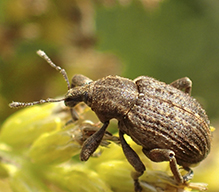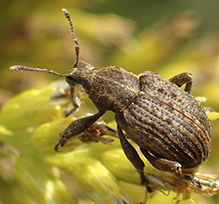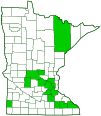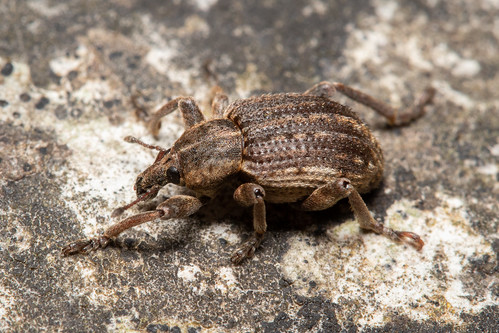clover leaf weevil
(Brachypera zoilus)
Conservation • Description • Habitat • Ecology • Distribution • Taxonomy
Conservation Status |
|
|||||||
| IUCN Red List | not listed |
|||||||
| NatureServe | NNA - Not applicable |
|||||||
| Minnesota | not listed |
|||||||
Description |
||
Clover leaf weevil is a common, small, exotic, cocoon weevil. It is native to the western Palearctic Region, which includes Europe, Northern Africa, and West Asia. It has spread widely through the trade of foodstuffs. It was first discovered in North America in Quebec in 1853. It now occurs throughout the United States and southern Canada. Adults are active in the spring, become inactive (estivate) in early summer, and become active again in late summer and fall. They are found in grasslands, woodland edges, roadsides, and agricultural crops. They are considered a significant pest in the U.S. Both adults and larvae feed on alfalfa, alsike clover, crimson clover, red clover, and white clover. Adults also feed on other plants in the pea (Fabaceae) family. They chew small holes in the leaves and stems. The damage is usually insignificant, but when they occur in large numbers in clover fields, they can cause a plant to stop growing or die. Adults are ¼″ to ⅜″ (6 to 9 mm) in length. The body is robust, oval, black, and hairy. The head, the plate on the first segment of the thorax (pronotum), and the hardened wing covers (elytra), are densely covered with gray, brown, yellowish-brown, and blackish-brown scales. The head is greatly elongated between the eyes and the mouth parts form a conspicuous snout (rostrum). The rostrum is thick and short, less than twice as long as wide. It is projected forward and slightly bent downward. They eyes are large. The antennae are short. slender, and elbowed. They have 11 segments. The last 3 segments are expanded and form a short, compact club. The section beyond the bend and supporting the club (funicle) has 7 segments. The pronotum is wider than long. It is abruptly narrowed in front, widest before the middle, then evenly tapered to the rear. The rear margin is much narrower than the base of the elytra. The surface is covered with dark and light scales, appearing mottled, and there is usually a pale stripe in the middle. The elytra are almost parallel sided. Each elytron has several narrow longitudinal grooves. The grooves are pitted (punctate). The intervals between the grooves (interspaces) are convex, those on the sides slightly convex, those in the middle more strongly convex. The first, third, fifth, and seventh interspaces are covered with light scales and have raised, darker, dot-like spots. The alternating interspaces are dark. The sides of the elytra are pale. The legs long and robust. The third segment (femur) of each leg does not have a small tooth on the underside. |
||
Size |
||
Total length: ¼″ to ⅜″ (6 to 9 mm) |
||
Similar Species |
||
Habitat |
||
Grasslands, woodland edges, roadsides, and agricultural crops |
||
Ecology |
||
Season |
||
One generation per year: May to November |
||
Behavior |
||
Adults and larvae feed at night. During the day they remain underground beneath the host plant. They also emerge to feed on cloudy days. |
||
Life Cycle |
||
Eggs, larvae, and newly emerged adults overwinter. Mature larvae produce a transparent, net-like cocoon in which to pupate. The cocoon may be attached to the host plant or be on the ground near the it. They emerge as adults in late May. Adults burrow into the ground and become inactive (estivate) during the warmest summer months, and reemerge in late summer. |
||
Larva Food |
||
Alfalfa, alsike clover, crimson clover, red clover, and white clover |
||
Adult Food |
||
Alfalfa, alsike clover, crimson clover, red clover, white clover, and other plants in the pea (Fabaceae) family |
||
Distribution |
||||
|
Sources |
|||
| 1/31/2024 | ||||
Occurrence |
||||
Common |
||||
Taxonomy |
|||
Order |
Coleoptera (Beetles) | ||
Suborder |
Polyphaga (Water, Rove, Scarab, Long-horned, Leaf, and Snout Beetles) | ||
Infraorder |
Cucujiformia | ||
Superfamily |
Curculionoidea (snout and bark beetles) | ||
Family |
Curculionidae (true weevils) | ||
Subfamily |
Hyperinae (cocoon weevils) | ||
Tribe |
Hyperini | ||
Genus |
Brachypera | ||
| Subgenus | Antidonus | ||
This species was originally described as Curculio zoilus by Giovanni Antonio Scopoli in 1763. In 1775, the same species was described as Curculio punctatus by Johann Christian Fabricius. The name Curculio zoilus was used earlier and therefore had precedence. In 1821, the species was moved to the genus Hypera as Hypera punctata. In 1834 it was moved to the genus Brachypera as Brachypera zoilus. The move was widely but not universally accepted. Some sources continue to use the names Hypera zoilus or Hypera punctata. In a recent revision of the genus Brachypera and Pseudhypera (Alonso-Zarazaga & Lyal, 2017), several species, including this one, were transferred to the genus Donus as Donus zoilus based on morphological and molecular studies. The move has not been widely accepted. |
|||
Synonyms |
|||
Curculio austriacus Curculio linzensis Curculio medius Curculio pictus Curculio punctatus Curculio zoilus Donus zoilus Hypera hostilis Hypera punctata Hypera zoilus Phytonomus fallaciosus Phytonomus lineellus Phytonomus opimus Phytonomus proximus Phytonomus rufus Rhynchaenus austriacus |
|||
Common Names |
|||
clover leaf weevil |
|||
Glossary
Elytra
The hardened or leathery forewings of beetles used to protect the fragile hindwings, which are used for flying. Singular: elytron.
Femur
On insects and arachnids, the third, largest, most robust segment of the leg, coming immediately before the tibia. On humans, the thigh bone.
Pronotum
The exoskeletal plate on the upper side of the first segment of the thorax of an insect.
Punctate
Dotted with pits (punctures), translucent sunken glands, or colored spots of pigment.
Rostrum
The stiff, beak-like projection of the carapace or prolongation of the head of an insect, crustacean, or cetacean.
Visitor Photos |
|||||
Share your photo of this insect. |
|||||
| This button not working for you? Simply email us at info@MinnesotaSeasons.com. Attach one or more photos and, if you like, a caption. |
|||||
Babette Kis |
|||||
Donus zoilus clover leaf weevil Donus zoilus, clover leaf weevil on goldenrod flowers, Barnes Prairie, Racine Co., WI. Photo taken September 14, 2021. |
 |
||||
 |
|||||
MinnesotaSeasons.com Photos |
|||||
|
|||||

Visitor Videos |
|||
Share your video of this insect. |
|||
| This button not working for you? Simply email us at info@MinnesotaSeasons.com. Attach a video, a YouTube link, or a cloud storage link. |
|||
Other Videos |
|||
| Brachypera Antidonus zoilus Scopoli, 1763 Θεόδωρος Φωτιάδης (Theodoros Fotiadis) |
|||
About
Feb 3, 2018 2.2.2018 |
|||


Created: 1/31/2024
Last Updated:




